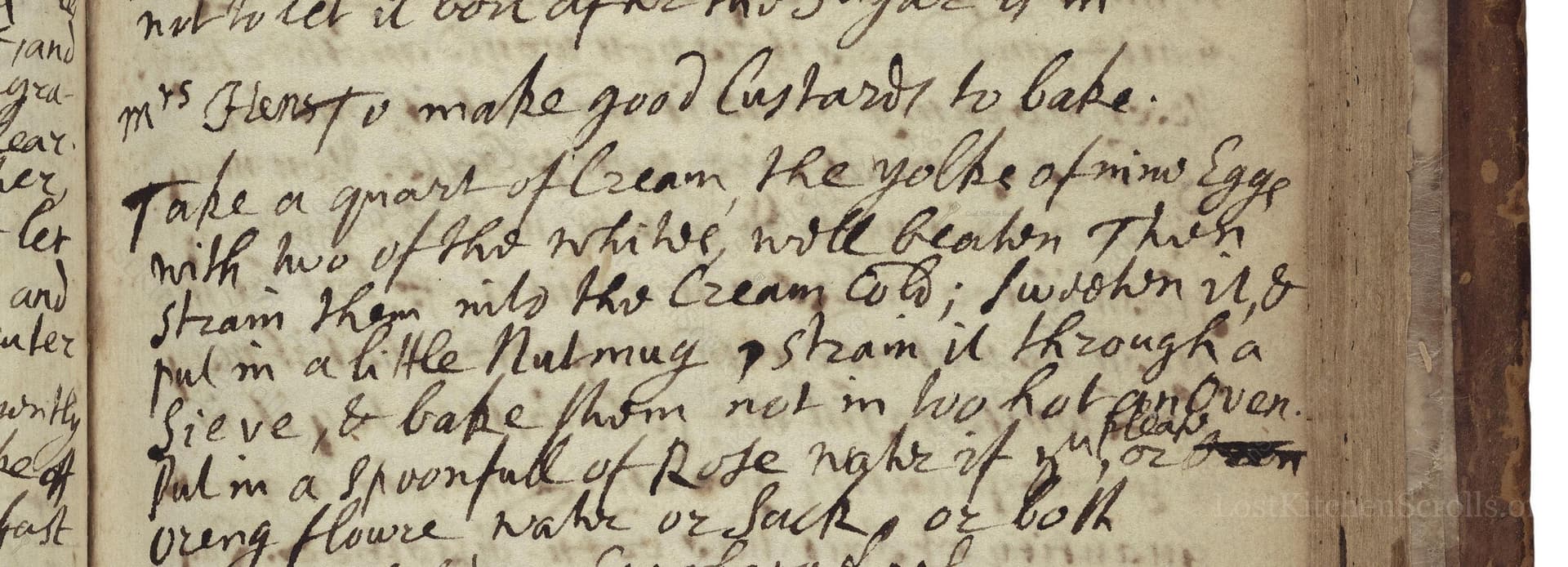Mrs Hensto To Make Good Custards To Bake
From the treasured pages of Receipt book of Penelope Jephson
Written by Penelope Patrick

Mrs Hensto To Make Good Custards To Bake
"Take a quart of Cream the yolke of nine Eggs with two of the whites well beaten Then strain them into the Cream cold; sweeten it, & put in a little Nutmeg & strain it through a sieve, & bake them in a hot oven. put in a spoonfull of Rose water or orreng flowre water or sack or both"
Note on the Original Text
The recipe is written in a conversational, direct manner typical of manuscript cookery books of the time. Spelling was highly variable; for example, 'yolke' for yolk and 'orreng flowre water' for orange flower water reflect period pronunciations and orthography. Instructions are imprecise by modern standards, assuming a level of culinary knowledge from the reader and encouraging adaptation. The recipe also allows for personal taste in sweetening and flavoring, highlighting the flexibility of historic kitchen practice.

Title
Receipt book of Penelope Jephson (1673)
You can also click the book image above to peruse the original tome
Writer
Penelope Patrick
Era
1673
Publisher
Unknown
Background
Step back into the sumptuous kitchens of the late 17th century with Penelope Patrick’s culinary collection—a feast of historic recipes, secret tips, and the irresistible flavors of Restoration England all bound together in a handwritten treasure.
Kindly made available by
Folger Shakespeare Library
The recipe is drawn from the late 17th century, specifically between 1671 and 1675, and is attributed to Penelope Patrick, a woman of genteel standing in England. Recipes like this offer a glimpse into the luxurious world of Restoration-era households, where costly ingredients like cream, imported spices, flower waters, and fortified wines were prized. Such custards were typically reserved for special occasions or well-to-do families. The inclusion of rose water or sack reflects contemporary tastes for aromatic and alcoholic infusions, echoing the era's fascination with flavors from across the globe.

Cooks of the 17th century would have used a large mixing bowl, a whisk or bundle of twigs for beating eggs, and a fine cloth or sieve for straining. Baking was done in brick ovens, preheated with wood fires until hot. Earthenware or metal dishes would serve to hold the custard during baking, and a spoon for measuring liquid flavorings. Precise temperature control would be by experience—judging the oven's 'heat'—rather than by calibrated devices.
Prep Time
15 mins
Cook Time
40 mins
Servings
8
We've done our best to adapt this historical recipe for modern kitchens, but some details may still need refinement. We warmly welcome feedback from fellow cooks and culinary historians — your insights support the entire community!
Ingredients
- 1 quart heavy cream
- 9 large egg yolks
- 2 large egg whites
- 1/2 cup granulated sugar (or to taste)
- 1 pinch grated nutmeg
- 1 tablespoon rose water or orange flower water or dry sherry (sack), or a mixture
- Optional: substitute for sack – any dry sherry
Instructions
- Begin by preheating your oven to 350°F (180°C).
- Take 1 quart of heavy cream and place it in a large bowl.
- In another bowl, separate 9 egg yolks and 2 egg whites, then whisk them together until well combined.
- Strain the beaten eggs into the cream to ensure smoothness, and keep the mixture cold.
- Stir in around 1/2 cup of sugar (adjust to taste), a pinch of grated nutmeg, and 1 tablespoon of rose water, orange flower water, sherry (sack), or a combination depending on your preference.
- For extra smoothness, strain the entire mixture through a fine sieve.
- Pour the custard into ramekins or a shallow baking dish.
- Place in a hot oven and bake for about 30-40 minutes, or until the custards set with a gentle wobble.
- Let cool before serving.
Estimated Calories
430 per serving
Cooking Estimates
It takes about 15 minutes to prepare the ingredients, and the custard bakes for 30 to 40 minutes. This recipe makes 8 servings, with each serving containing about 430 calories.
As noted above, we have made our best effort to translate and adapt this historical recipe for modern kitchens, taking into account ingredients nowadays, cooking techniques, measurements, and so on. However, historical recipes often contain assumptions that require interpretation.
We'd love for anyone to help improve these adaptations. Community contributions are highly welcome. If you have suggestions, corrections, or cooking tips based on your experience with this recipe, please share them below.
Join the Discussion
Rate This Recipe
Dietary Preference
Main Ingredients
Culinary Technique

Den Bockfisch In Einer Fleisch Suppen Zu Kochen
This recipe hails from a German manuscript cookbook compiled in 1696, a time whe...

Die Grieß Nudlen Zumachen
This recipe comes from a rather mysterious manuscript cookbook, penned anonymous...

Ein Boudain
This recipe comes from an anonymous German-language manuscript cookbook from 169...

Ein Gesaltzen Citroni
This recipe, dating from 1696, comes from an extensive anonymous German cookbook...
Browse our complete collection of time-honored recipes



